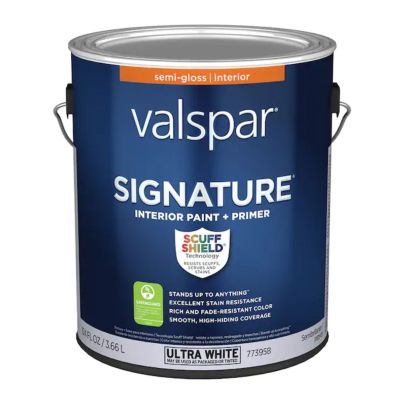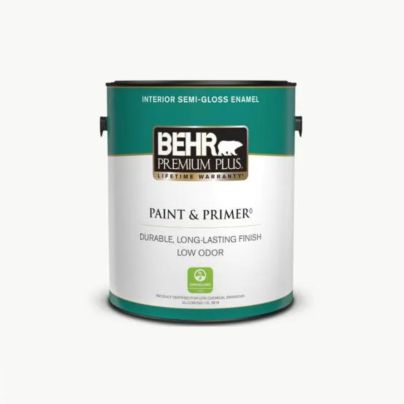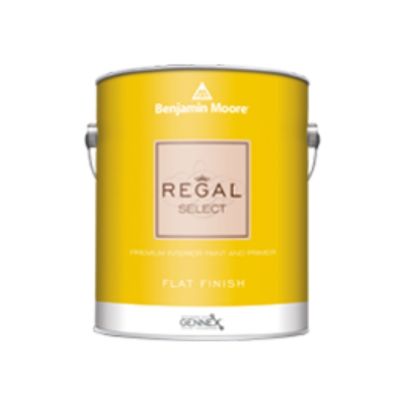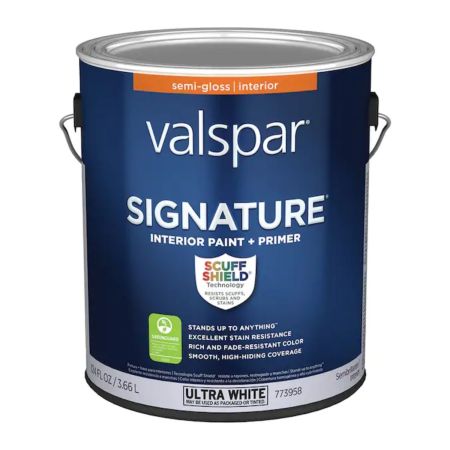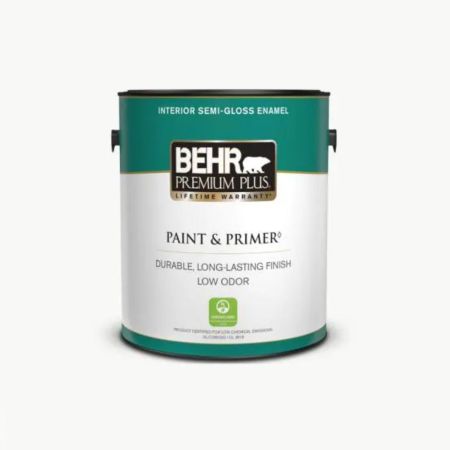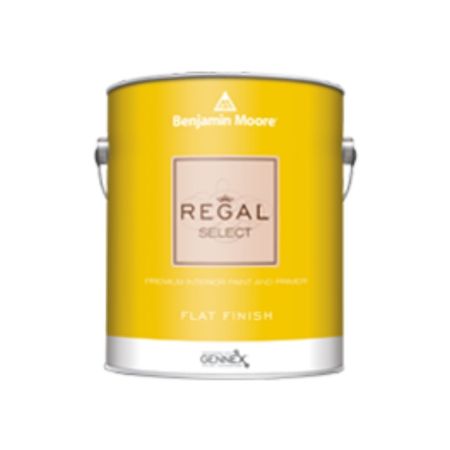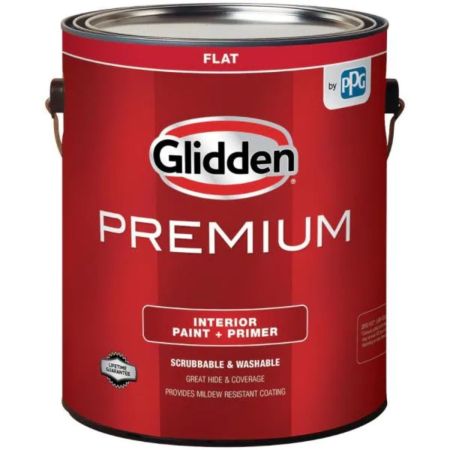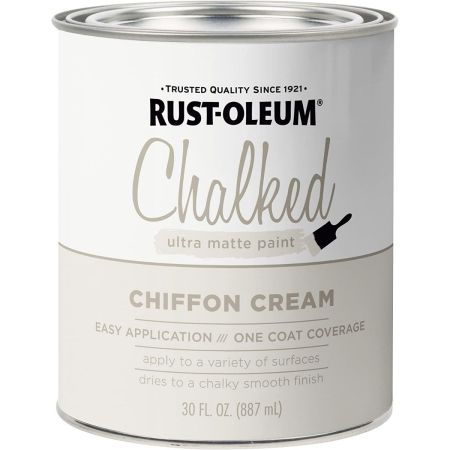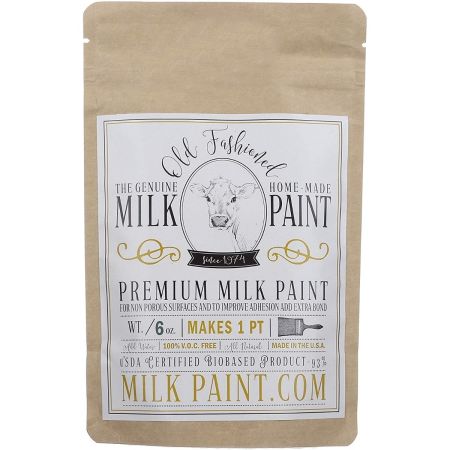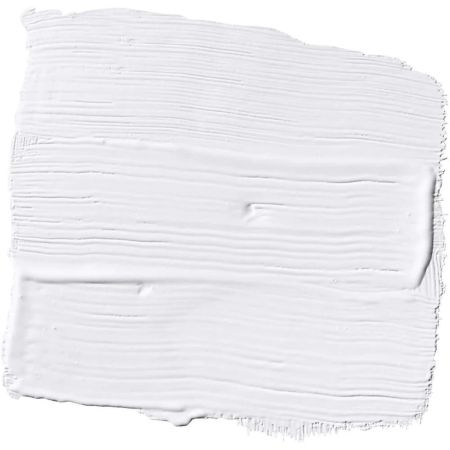We may earn revenue from the products available on this page and participate in affiliate programs. Learn More ›
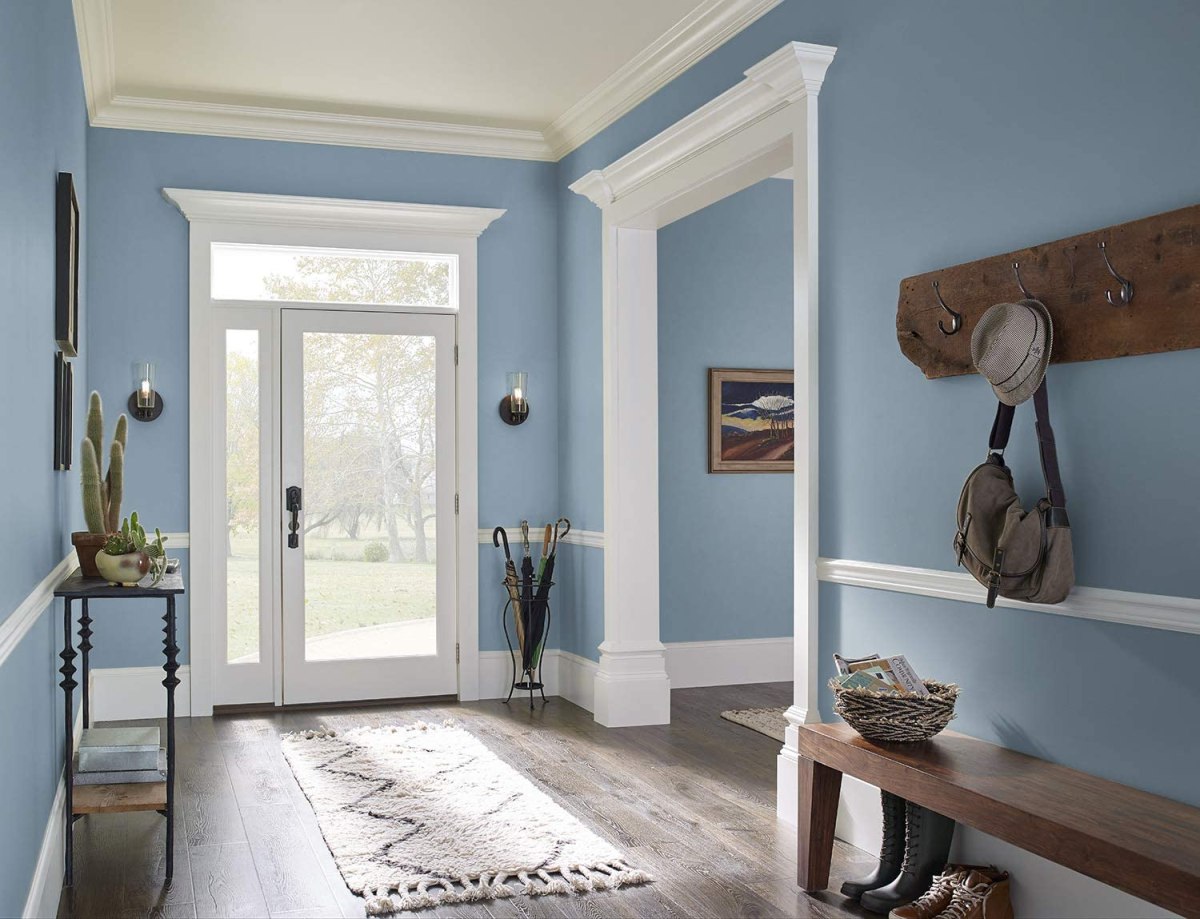
Most of us don’t think much about paint beyond its color, but there are chemicals in paint called volatile organic compounds (VOCs) that can be toxic. VOCs are also found in paint stripper, primer, and household items like carpet, upholstery, and some furniture.
New, eco-friendly paints are called low-VOC paints, and they contain fewer volatile chemicals than regular paints. The best low-VOC paint for you depends on the project you’re working on and the desired finish type. Here’s what to look for when shopping for low-VOC paint along with our recommendations for some top options.
- BEST OVERALL: Valspar Signature Semi-Gloss Tintable Interior Paint
- BEST BUDGET: Behr Premium Plus Ultra Pure White Interior Paint
- BEST HIGH-END: Benjamin Moore Regal Select Interior Paint
- KITCHENS AND BATHROOM PICK: Glidden Premium 1 gal. Base 1 Flat Interior Paint
- BEST FOR FURNITURE: Rust-Oleum Ultra Matte Interior Chalked Paint 30 oz
- BEST FOR THE ENVIRONMENT: Old Fashioned Milk Paint Non-VOC Powder Paint
- HONORABLE MENTION: PPG Diamond Crystal Clear Interior Paint with Primer
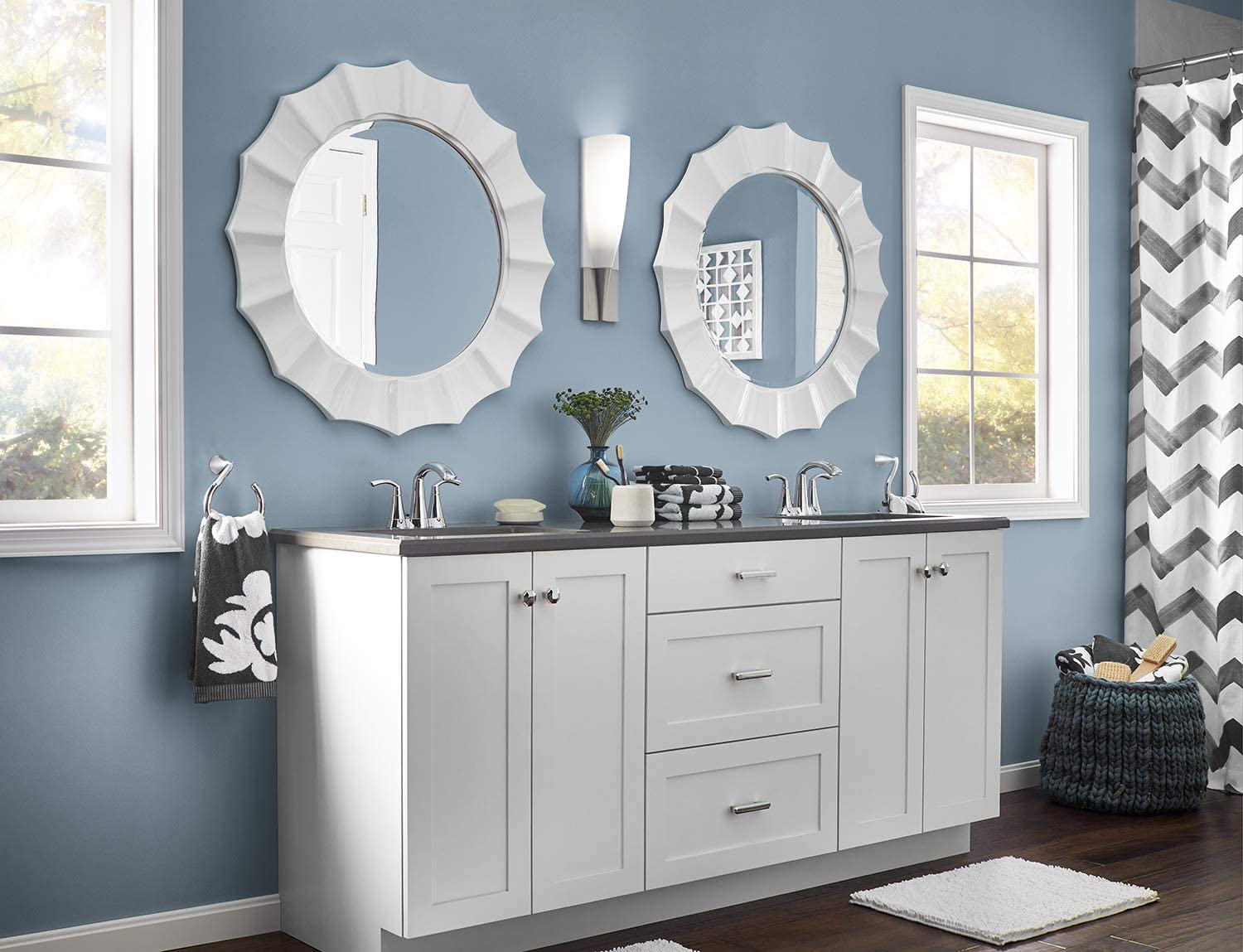
Low-VOC vs. No-VOC Paint
Before shopping for your paint project, It’s important to clarify the differences in the amount of toxic compounds contained in low-VOC paints compared to those classified as no-VOC.
Low-VOC
With low-VOC paint, there are no government guidelines for certifying a paint as low-VOC. But, some manufacturers have limited the amount of toxins in their low-VOC paints to less than 50 grams per liter (g/L) for flat finish paints and no more than 110 g/L for non-flat finish paints.
Manufacturers who follow that guideline can have their paint products certified as GS-11 by the nonprofit organization Green Seal. Their paint can also earn a GREENGUARD Indoor Air Quality Certification from UL, a nonprofit safety organization; this indicates it is tested annually and complies with voluntary low-VOC standards.
No-VOC/Zero-VOC
No-VOC or zero-VOC paint products contain minimal—if any—volatile organic compounds, but they may contain trace amounts, up to 5 g/L. The color you tint the paint may contain small amounts of VOCs, but these are still among the least toxic paints on the market.
A handful of zero VOC paints are available from major manufacturers. You can also find natural paints, such as milk paint that will not off-gas any fumes.
What to Consider When Choosing the Best Low-VOC Paint
Interior paints come with an oil or water base, but the former type contains more VOCs. Eco-friendly paints usually contain latex or acrylic water-based formulas, with various elements to consider based on the nature of your project. Keep the following paint characteristics and features in mind before making a choice:
Durability
How durable an interior paint is depends on several factors; note that color fastness (fade resistance) is a separate topic discussed below.
- Paint Quality: The best latex and acrylic paints contain premium ingredients, such as more acrylic solids and pigments. They’re often thicker and more viscous (sticky) than lower-quality paints, making them stronger and longer lasting.
- Number of Coats: More coats of paint will render a more durable surface. Most interior paints involve two coats, though darker colors may require a third to even out the finish.
- Even mixing: Ingredients in paint can settle to the bottom of the can over time. If it’s been a while since the paint was purchased, stir it thoroughly before use to ensure the compounds perform effectively together.
- Application: Applying paint with a roller or brush instead of a sprayer can leave a thicker, more durable coating on a surface. More information on paint application can be found below.
- Finish: In general, the higher the gloss, the more durable and washable paint is. If you’re unfamiliar with paint finishes, consult the next section of this guide.
- Treatment(s): Some interior paint is formulated specially for certain environments. For instance, paint labelled as “mildew resistant” is preferred for humid regions and bathrooms, while “UV resistant” paint is a sensible option for sun-filled rooms.
Color and Finish
Low-quality paint may contain cheap pigments such as talc, clay, and silica that tend to fade over time. This is especially true if the painted surface has a southern exposure and receives direct sun. Dark colors are also more likely to fade than lighter hues when exposed to sunlight.
Beyond choosing an interior paint color, settling on the right finish is also important. Paint finishes vary in visual effect and VOC content, making them more or less suitable for certain spaces:
- Flat/matte finishes are at the lowest level of glossiness. This type of finish is nonreflective, allowing it to hide surface inconsistencies and appear smooth and velvety. This neutral effect makes a flat finish particularly popular for furniture and kitchen cabinets.
- Eggshell and satin finishes have more reflectivity and sheen in comparison, but they don’t shine nearly as bright as semi- and high-gloss. This middle ground makes them ideal for bathrooms, kitchens, and bedrooms where natural light may be scarce.
- Semi-gloss and high-gloss finishes are designed to accent a room with a highly reflective formula. Use these finishes on doors, moldings, window frames, baseboards, and other trim. The reflectivity focuses the eye on the main decor, similar to the way a border or picture frame draws the focus to the centered art.
Paints with a harder, shinier finish, like glosses and enamels, contain higher VOC levels because those surfaces are created by toxic chemicals and solvents. You’ll find the most low-VOC options in flat paints, and a growing variety of satin and semi-gloss options are available as well.
Coverage and Drying Time
Some downsides to low-VOC paints are reduced coverage and longer dry times. However, there are newer varieties with primer included for better coverage that can also dry quickly. Paint manufacturers are improving these eco-friendly paints, but you may experience longer dry times with some brands (up to a few days for some types of milk paint) and may have to wait longer to apply a second coat.
If you’re covering a dark wall with a lighter color paint, you may need three coats of low-VOC paint for full coverage. Standard low-VOC paint coverage is 300 to 400 square feet per gallon of paint.
Prep and Application
For optimal adherence, the interior surface must be clean and dry, as paint does not adhere well to damp surfaces. Any loose or peeling paint should be scraped away. Smaller projects, such as pieces of furniture, can be prepped using a paint stripper to remove existing paint. Draping nearby objects with drop cloths keeps them protected from splatters, and using painter’s tape helps create a clean, crisp paint edge.
Most interior paint is easy to apply with a paint brush or roller. Using a paint sprayer is the quickest application method, but these tools risk accidental overspray. A combination of techniques can be used for best results, such as spraying or rolling on a coat of paint followed by brushing in a process known as “back brushing.”
Our Top Picks
Whether you need a low or no-VOC paint, the list below is filled with viable options for your next bathroom, kitchen, bedroom, or whole-house upgrade.
Best Overall
Valspar Signature Semi-Gloss Tintable Interior Paint
See ItIf you’re looking for a combination paint and primer product, look no further than Valspar Signature Semi-Gloss Tintable Interior Paint. This low-VOC paint bears the GREENGUARD certification for low chemical emission standards. It has a dry time of one hour for the initial coat and 4 hours for subsequent coats.
This Valspar Signature paint comes in a semi-gloss finish, making it durable and washable, and you can have it tinted in your choice of colors. One gallon covers up to 400 square feet and it is also safe to use on fiberglass, metal, and trim. Plus, this paint is tough enough to be washed or scrubbed if needed.
Product Specs
- VOC level: Low-VOC
- Color and Finish: Semi-gloss
- Drying time: 1 hour (first coat), 4 hours (subsequent coats)
Pros
- Tintable to any color required
- Fast-drying
- Comes in multiple finishes
- Durable, washable, and scrubbable
Cons
- Not suitable for use on furniture
- Not pre-tinted or stain-blocking
Best Budget
Behr Premium Plus Ultra Pure White Interior Paint
See ItYou don’t have to spend a lot to get quality low-VOC paint. The Behr Premium Plus Ultra Pure White Interior Paint delivers a durable, semi-gloss finish that’s well-suited for cabinets, doors, trim, furniture, and more. This paint is GREENGUARD-certified and contains mold and mildew inhibitors, making it suitable for high humidity spaces like bathrooms and laundry rooms.
The Behr Premium Plus paint comes with primer mixed in so there’s no need to apply a separate base coat. This paint dries to the touch in one hour, and you can apply a second coat after 2 hours. It comes in bright white but can be tinted, and 1 gallon covers up to 400 square feet.
Product Specs
- VOC level: Low-VOC
- Color and Finish: Semi-gloss
- Drying time: 1 hour (first coat), 2 hours (2nd coat)
Pros
- Can be tinted for multiple color options
- Comes primer-mixed
- Mold and mildew-protecting
- Suitable for furniture, cabinets, doors, and more
Cons
- Not recommended in living rooms, bedrooms, or hallways
Best High-End
Benjamin Moore Regal Select Interior Paint
See ItNeither bacteria nor direct sunlight will mar a coat of this mildew- and fade-resistant line of paints. This high-end acrylic paint and primer combo comes in a wide variety of colors to suit different interiors. The water-based paint is classified among zero VOC paints and is formulated with stain release technology, so it’s easy to wipe clean with minimal scrubbing.
This non-toxic interior paint dries in 1 hour and cures in 14 days, leaving virtually no brush strokes behind. It’s pricier than other acrylic paints, but the quality formulation makes it worthy in the long run.
Product Specs
- VOC level: No-VOC
- Color and Finish: Flat
- Drying time: 1 hour
Pros
- Comes in multiple colors
- Integrated with stain release technology
- Mildew and fade-resistant
- Cures in just 14 days
Cons
- Ideal for low-traffic areas only
- Expensive compared to similar options
Kitchens and Bathrooms Pi
Glidden Premium 1 gal. Base 1 Flat Interior Paint
See ItFor a durable finish and protection against mildew, check out this Glidden Premium paint, suitable for use in high humidity areas like bathrooms, laundry rooms, and kitchens. This paint is zero-VOC, but the tint you choose to color this paint may add a small amount of VOCs, especially if you opt for hues of red, yellow, or orange.
This Glidden Premium product is an interior paint and primer combo, and 1 gallon will cover up to 300 square feet. It’s available in flat, eggshell, satin, and semi-gloss finishes. Plus, this paint takes 2 hours to dry and is durable enough to scrub and wash if needed. If needed, this option also has a selection of exterior paints.
Product Specs
- VOC level: No-VOC
- Color and Finish: Flat
- Drying time: 2 hours
Pros
- Acts as a paint and primer
- Suitable for use in high humidity areas
- Durable and mildew-protecting
- Comes in multiple finishes
Cons
- Some tints contain VOCs
Best for Furniture
Rust-Oleum Ultra Matte Interior Chalked Paint 30 oz
See ItIf you’re looking for chalk paint, consider Rust-Oleum Ultra Matte Interior Chalked Paint. This low-VOC paint dries to a soft, matte finish and is suitable for use on your favorite furniture and home decor projects. The paint features high adhesion for metal, ceramic, canvas, and pre-painted items, and it dries to the touch in just 30 minutes.
The Rust-Oleum Ultra Matte Interior Chalked Paint comes in a variety of pre-mixed colors in a 30-ounce can, which is about a quarter of a gallon. One can provide up to 150 square feet of coverage.
Product Specs
- VOC level: Low-VOC
- Color and Finish: Matte finish
- Drying time: 30 minutes
Pros
- Dries with a chalk-like finish
- Can be used on furniture, wood, metal, ceramic, and canvas
- Quick drying time
- Comes in 12 colors
Cons
- Primer may be needed for bare wood; redwood, mahogany, and fir
- May not be suitable for drywall or trim
Most Eco-Friendly
Old Fashioned Milk Paint Non-VOC Powder Paint
See ItFor a completely VOC-free painting experience, try Old Fashioned Milk Paint Non-VOC Powder Paint. This non-toxic, all-natural paint comes as a powder you mix with water to use. It’s available in 32 colors, or choose a white base and add your own natural pigments, such as ground mica pigment powder (sold separately) for a custom look.
For the best results, apply Old Fashioned Milk Paint with a brush or foam applicator. This paint is also suitable for rag-type application to achieve a textured or distressed finish. Due to the variations in texture, this paint is not ideal for application with a spray gun. Coverage will depend on the thickness of the paint when mixed.
Product Specs
- VOC level: No-VOC
- Color and Finish: Velvet
- Drying time: 30 minutes
Pros
- Non-toxic, all-natural paint
- Can be mixed with custom tints
- Texture is customizable
- Comes in 32 colors
Cons
- Custom pigments sold separately
- May require brush or foam applicator
- Requires dilution before use
Honorable Mention
PPG Diamond Crystal Clear Interior Paint with Primer
See ItThis water-based acrylic paint-and-primer line is a favorite for its scrubbable, washable, and stain-resistant qualities ideal for low-traffic spaces like dining and formal living rooms. The zero-VOC formula is tintable and emits minimal fumes. You can choose between flat, eggshell, satin, and semi-gloss finishes.
PPG Diamond offers more than 1,000 colors for tinting with this paint, so it’s a solid choice when looking for unconventional shades or hoping to match an existing hue. Once the interior paint goes on, it dries in 30 to 60 minutes and cures in 14 days.
Product Specs
- VOC level: No-VOC
- Color and Finish: Satin
- Drying time: 30-60 minutes
Pros
- Built-in stain-resistance and mildew protection
- Cures in 14 days
- Washable and scrubbable after dried
- Offered in many finishes and colors
Cons
- Suitable for low-traffic areas
Our Verdict
With hundreds of paint companies on the market producing no or low-VOC products, it can be hard to choose the right one for your space, furniture, or project. One of the best low-VOC options is the Valspar Signature paint with its semi-gloss finish that dries in just 1 hour on cabinets, doors, and trim. Alternatively, Benjamin Moore Regal is a worthy upgrade pick with a classic flat finish that boasts stain release technology.
How We Chose the Best Low-VOC Paints
The right low-VOC paint can increase your indoor air quality by providing low chemical emissions in homes with pets and children while still performing like conventional paints. Our picks for the best low-VOC paint generally contain fewer than 50 grams of volatile organic chemicals per liter and offer good coverage. Many can be applied with a brush or roller, and cleanup involves only soap and water.
The featured picks also vary between low-VOC and no-VOC paints to satisfy your personal preference. Though a few of these options require prep or dilution before applying, most come in large quantities, multiple color options, and varying finishes. Many of the above paints are also compatible with metal, ceramic, canvas, fiberglass, and trim.
Drying time is also prioritized in this list, as many of these picks only take 30 minutes to 1 hour to dry after applying the first coat. Finally, select paint options also offer mildew, mold, and stain resistance.
FAQs
Still have questions about low-VOC paint? Here are some answers to help you pick the best low-VOC paint for your project.
Q: What is considered low-VOC in paint?
The federal government does not set guidelines for low-VOC paint, but some paint manufacturers have voluntarily agreed to cap the amount of VOCs in their paint products to less than 50 grams per liter (g/l).
Q: Does low-VOC paint contain any chemicals?
It may contain chemicals and solvents not classified as volatile organic compounds. For the least toxic paints, look for all-natural ingredients listed on the label.
Q: Do low-VOC paints smell?
Low-VOC paints have much less odor than other paints, but they may still have a slight smell.
Q: How long does it take for low-VOC paint to dry?
Drying time depends on the brand. Some low-VOC paints dry to the touch in one hour and can be recoated in two hours, while others may require a day or more to dry completely.
